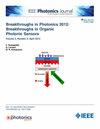Photonics Breakthroughs 2024: Nonlinear Photonic Computing at Scale
IF 2.4
4区 工程技术
Q3 ENGINEERING, ELECTRICAL & ELECTRONIC
引用次数: 0
Abstract
A photonic neural network utilizes photons instead of electrons to process information, with the prospect of higher computing efficiency, lower power consumption, and reduced latency. This paper reviews several recent breakthroughs in large-scale photonic neural networks incorporating nonlinear operations. Specifically, we highlight our recent work, which leverages multiple light scattering and second harmonic generation in a slab of disordered lithium niobate nanocrystals for high-performance nonlinear photonic computing. The interplay of these optical effects not only enhances the computational capabilities of photonic neural networks but also increases the number of photonic computing operations. In addition, we discuss current challenges and outline future directions of nonlinear photonic computing. These advancements pave the way for exploring new frontiers in optical computing, unlocking opportunities for innovative experimental implementations, broad applications, and theoretical foundations of photonic neural networks.光子学突破2024:大规模非线性光子计算
光子神经网络利用光子代替电子来处理信息,具有更高的计算效率、更低的功耗和更短的延迟。本文综述了近年来在包含非线性运算的大规模光子神经网络方面取得的一些突破。具体来说,我们重点介绍了我们最近的工作,该工作利用无序铌酸锂纳米晶体板中的多次光散射和二次谐波产生进行高性能非线性光子计算。这些光效应的相互作用不仅增强了光子神经网络的计算能力,而且增加了光子计算运算的次数。此外,我们讨论了当前的挑战,并概述了非线性光子计算的未来方向。这些进步为探索光学计算的新领域铺平了道路,为光子神经网络的创新实验实现、广泛应用和理论基础打开了机会。
本文章由计算机程序翻译,如有差异,请以英文原文为准。
求助全文
约1分钟内获得全文
求助全文
来源期刊

IEEE Photonics Journal
ENGINEERING, ELECTRICAL & ELECTRONIC-OPTICS
CiteScore
4.50
自引率
8.30%
发文量
489
审稿时长
1.4 months
期刊介绍:
Breakthroughs in the generation of light and in its control and utilization have given rise to the field of Photonics, a rapidly expanding area of science and technology with major technological and economic impact. Photonics integrates quantum electronics and optics to accelerate progress in the generation of novel photon sources and in their utilization in emerging applications at the micro and nano scales spanning from the far-infrared/THz to the x-ray region of the electromagnetic spectrum. IEEE Photonics Journal is an online-only journal dedicated to the rapid disclosure of top-quality peer-reviewed research at the forefront of all areas of photonics. Contributions addressing issues ranging from fundamental understanding to emerging technologies and applications are within the scope of the Journal. The Journal includes topics in: Photon sources from far infrared to X-rays, Photonics materials and engineered photonic structures, Integrated optics and optoelectronic, Ultrafast, attosecond, high field and short wavelength photonics, Biophotonics, including DNA photonics, Nanophotonics, Magnetophotonics, Fundamentals of light propagation and interaction; nonlinear effects, Optical data storage, Fiber optics and optical communications devices, systems, and technologies, Micro Opto Electro Mechanical Systems (MOEMS), Microwave photonics, Optical Sensors.
 求助内容:
求助内容: 应助结果提醒方式:
应助结果提醒方式:


